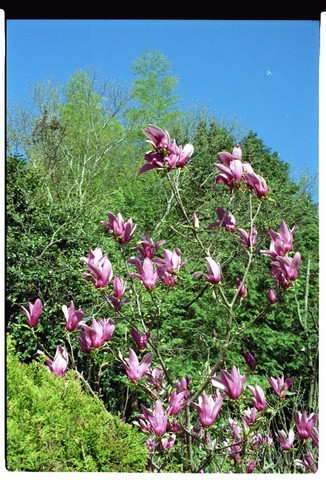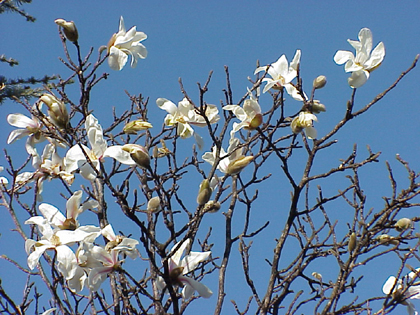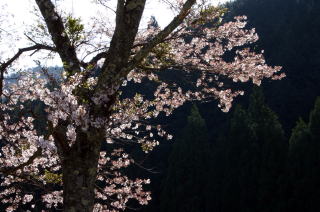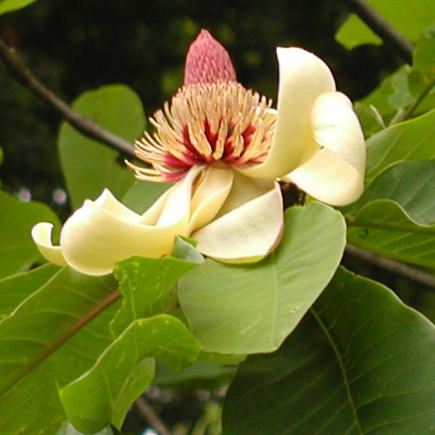:::::::::::::::::::::::::::::::::::::::::::::::::::::::::::::::::::::::::::::::::::::::::::::::::::::
Magnolia (mokuren)
***** Location: Japan, worldwide
***** Season: Mid-Spring
***** Category: Plant
*****************************
Explanation
Magnolia, lily magnolia (mokuren 木蓮, 木蘭) Magnolia liliflora
Literally: Tree Lotus Flower, Tree Orchid.

The most cultivated version in Japan. With purple blossoms.
violet magnolia (shimokuren 紫木蘭) Lily magnolia blossoms
white magnolia (hakuren 白蘭)Magnolia denudata
Sarasa Mokuren (更紗木蓮)
Karasu Mokuren (烏木蓮)
Magnolia buds,
which are visible long before the fowers open, add a sence of the early spring to this flower.

The country of origin is China, but they have been introduced to Japan in the 10th century as a garden flower to enjoy in spring. The blossom has six petals, which get as long as 10 centimeters. They all point in the same direction when open. They have a faint smell of spring. The form of the blossom resembles the lotus, hence the Japanese name, which can be written with the Chinese charactersfor lotus 蓮 or orchid 蘭.
The fallen petals create a violet carpet and evoke the feeling of sadness and passing on of life, some sort of "mono no aware".
The white magnolia, which flowers earlier, found its way to Europe in the 18th/19th century and became very popular soon. Magnolia is the English version of the word "mokuren" .
Photos and text by Gabi Greve
:::::::::::::::::::::::::::::::::::::::::::::::::::::::::::::::::::::::::::::::::::::::::::::::::::::
kigo for early summer
taisanboku no hana 泰山木の花 (たいさんぼくのはな)
taizanboku no hana 大山木の花(たいざんぼくのはな)
taisanboku no hana 大盞木の花(たいさんぼくのはな)
blossoms of the Magnolia grandiflora
ooyama renge 大山蓮花 (おおやまれんげ) "lotus of a large mountain"
..... 天女花(おおやまれんげ)
miyama renge 深山蓮花(みやまれんげ)
Magnolia sieboldii
*****************************
Worldwide use
USA
The magnolias in the southern USA, are similar to Big Fragrant Magnolia mentioned below, big petals creamy to milky white. The trees are considered one of the few broadleaf evergreens.
magnolia --
a pleasant scent
in the shade
Their large blossoms shed the palm sized petals looking like porcelan white giant Chinese soup spoons! Their blossoms' fragrance is delicate and pleasing on a sultry summer evening walk.
Chibi (Dennis Holmes)
*****************************
Things found on the way
. sange 散華 "scattering blossoms" amulets .
*****************************
HAIKU
magnolia blossoms -
the sky today
without a blemish
Look at the corresponding photo by Gabi Greve here:
http://happyhaiku.blogspot.com/2005/05/magnolia.html
xxxxxxxxxxxxxxxxxxxxxxxxxxxxx
mirroring
coromandel magnolia
in the fishpond
© Geert Verbeke
xxxxxxxxxxxxxxxxxxxxxxxxxxxxx
far away beneath
the magnolia petals
the morning sun ~
Narayanan
Look at a beautiful photo at the Haiku Gallery
http://home.alc.co.jp/db/owa/PH_detail?photo_sn_in=1130
xxxxxxxxxxxxxxxxxxxxxxxxxxxxx
blooming magnolia
girls fidget
for Easter pictures
Mary Gamble
http://www.millikin.edu/haiku/courses/globalspring2001/MaryGamble.html
xxxxxxxxxxxxxxxxxxxxxxxxxxxxx
Ein Frühlingshauch der
Morgenröte färbte zart
die Magnolien.
a faint spring breeze
in the pink morning colors
the magnolia
Magnolien gehören mit zu den ersten Frühlingsblühern. Ich liebe ihre porzellanartigen, tulpenförmigen, pastellfarbigen Blüten.
Dietlinde Heider
Look at her German Akrostichon about MAGNOLIE
http://www.haikulinde.de/weblog/archives/00000102.htm
Great Photo of one blossom
by Brigitte Blechschmidt
http://www.fotocommunity.de/pc/pc/mypics/442486/display/1286261
:::::::::::::::::::::::::::::::::::::::::::::::::::::::::::::::::::::::::::::::::::::::::::::::::::::
magnolia buds
swaying before the bamboo -
just that
Gabi Greve, April 2009
(Click for the photos!)
*****************************
Related words
***** Mountain Magnolia (kobushi 辛夷)
こぶし 辛夷 木筆
yama mokuren 山木蓮(やまもくれん)Magnolia kobus
..... kobush hajikami 、こぶしはじかみ
yama araragi やまあららぎ
shide kobushi 幣辛夷(しでこぶし)
tauchizakura 田打桜(たうちざくら)
kigo for mid-spring
Magnolia kobus

http://www.salisbury.edu/arboretum/Magnolia/MaKo/MaKoHM.html
Other Japanese names:
Mountain Magnolia (yama kobushi 山辛夷、yama araragi やまあららぎ, shide kobushi しでこぶし)
Cherry for starting planting the fields (tauchi sakura 田打桜)
This variety is native to Japan. It grows in many mountainous areas. The name means litteraly: small fist, since the buds look like such. They are also used in Chinese medicine.
In my area of Okayama, the hot spring of Okutsu (奥津) celebrates its annual Kobushi Matsuri, the Wild Mountain Magnolia Festival during the first two weeks of April. The sight in the gorge with the steep cliffs shining white with all the flowering trees is superb.

http://www.tamatele.ne.jp/~hiroyuki-n/416-sinrinkouenn/4162-pronoazi.html
wild mountain magnolia -
the ravine alive with
car exhaust
There are so many people squeezing in the small ravine, it is amazing.
Gabi Greve
::::::::::::::::::::::::::::::::::::::::::::::::::::::::::::::::::::::::::::::::::::::
*****Big Magnolia Flower (Hoo Flower)
朴の花(ほおのはな) hoo no hana
hoo no hana 厚朴の花(ほおのはな)
hoo sange 朴散華(ほおさんげ)
kigo for early summer
Magnolia hypoleuca. The fragrant magnolia.

http://www010.upp.so-net.ne.jp/pha/flo0405hounoki.htm
This beautiful flower on its large leaves is a pleasure to find in any forest. Since the flowers sit on the large leaves, they are hard to detect and better viewed from far first. The contrast of the white flowers with the dark green leaves is splendid. The small petals in the center of the flower are also worth a second look.
It has a lovely smell and the leaves are used for fragrant teas and even bean paste (miso). The name HOO derives from "fragrance" 包.
The tree has a slightly white bark. The wood is soft and easy to process, it is used for wooden clogs Geta 下駄 and piano parts.
Gabi Greve
雷鳴のしづもる夜明け朴の花
early morning
after a night of thunder -
fragrant magnolia blossom
(Tr. Gabi Greve)
Haiku-An - Natsu
. sange 散華 "scattering blossoms" amulets .
:::::::::::::::::::::::::::::::::::::::::::::::::::::::::::::::::::::::::::::::::::::::::::::::::::::::::::::::::::::::::::
[ . BACK to DARUMA MUSEUM TOP . ]
[ . BACK to WORLDKIGO . TOP . ]
:::::::::::::::::::::::::::::::::::::::::::::::::::::::::::::::::::::::::::::::::::::::::::::::::::::::::::::::::::::::::::







4 comments:
Beautiful photos and haiku, Gabi!
whispers --
falling magnolia
petals
taisanboku, another kind of magnolia, Magnolia gradiflora.
Southern Magnolia,
Southern Charm
泰山木(たいさんぼく)
http://homepage1.nifty.com/s-ozeki/taisanboku.htm
http://www.mitomori.co.jp/hanazukan/hanazukan2.6.32taisan.html
Blooming magnolia
waiting my father’s medicine
The hospital window
Etsuko Yanagibori
http://groups.yahoo.com/group/
cherrypoetryclub/message/23396
Quote from the Japan Times, March 2007
Japan is home to several wonderful species of magnolia. Kobushi, or Northen Japanese magnolias (Magnolia kobus), grow about 12 meters tall, and flower on bare branches. Their simple white flowers are about 10 cm across and have a delicate fragrance. Shidekobushi, or Star magnolias (M. stellata) are similar but more dainty. Typically, they can attain about 4 meters in height, and their flowers -- which may be white or pink -- have 12 or more petals.
Both the flower- and leaf-buds shelter from the winter cold inside woolly sheaths, which they throw off in spring.
A Star magnolia in full bloom is a delightful sight, and the plants are ideal for growing in a large pot or small garden. There are also some beautiful cultivars to choose from, but unfortunately the wild trees are becoming scarce, mainly due to loss of natural habitat.
This is a great shame, because magnolias were among the very earliest flowering plants on Earth.
Fossils show that magnolias were growing in temperate forests during the Cretaceous Period, 144 to 65 million years ago.
Linda Inoki
http://search.japantimes.co.jp/cgi-bin/fe20070321li.html
Legend from Fukushima 耶麻郡 Yama district 高郷村 Takasato mura
A hoo no ki 朴の木 Magnolia hypoleuca tree with three trunks is sacred to Yamanokami and is not to be cut down.
Other large Magnolia trees of this kind are also sacred to him, If they need to be cut down, wood cutters have to make an offering of shinshu 神酒 ritual rice wine and ask Yamanokami permission to cut this tree.
.
https://japanshrinestemples.blogspot.jp/2017/08/yama-no-kami-08-regional.html
.
Post a Comment